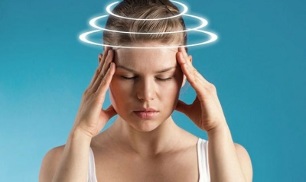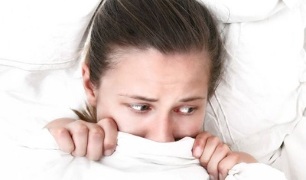
Spinal pathologies often cause completely unexpected symptoms.
At first glance, it has nothing to do with the disease. However - a person has cervical osteochondrosis, and dizziness, fear and depression can also easily become a part of life.
For successful treatment, it is important to correctly identify the root cause of these problems.
Dizziness in osteochondrosis: causes
Cervical osteochondrosis is especially dangerous because it disrupts the blood supply to the brain. Deformation of the discs and vertebrae can cause the spinal artery to constrict, providing a quarter of the blood the brain needs.
Dizziness is a direct result of oxygen starvation in the brain. In the milder stages of the disease, it usually occurs intermittently and for a short time. Dizziness may occur after sleep or when there is a sudden change in body position. If the disease develops, this condition can last for hours. It is often accompanied by nausea, vomiting and visual disturbances.
It is very important to correctly determine the cause of the problem. The head can only feel dizzy from osteochondrosis. The same symptom can be given by disorders of the heart and blood vessels, anemia and other diseases. In this case, approaches to treatment should be completely different. Often misdiagnosis resulted in people being treated for years for hypertension or other similar diseases instead of dealing with the spine.
Blood pressure and cervical osteochondrosis
In this case, cervical osteochondrosis can also cause vegetative-vascular dystonia. The causes are in the pinching of the vertebral artery, as in muscle spasms. Intracranial pressure is a particularly painful reaction to osteochondrosis.

This phenomenon can manifest itself as headache, heaviness, tinnitus and visual disturbances. The use of traditional medicines to treat hypertension is ineffective (or short-lived). Again, a correct diagnosis is the key to successful treatment.
Increased pressure can also cause pain, so the manifestations of VSD in osteochondrosis can be very strong.
If the chest is affected in addition to the neck, there may be interruptions in the work of the heart, arrhythmias and a feeling of tightness in the chest. Still, heart medications do not work.
Osteochondrosis is very dangerous because it causes symptoms similar to those of other dangerous diseases. Many things can be attributed to him, and the moment when you need an ambulance for the heart and blood vessels can be missed.
What to do if you feel dizzy with cervical osteochondrosis
If the diagnosis has not yet been made, and dizziness may be suspected due to a change in posture, osteochondrosis may be suspected. Both necks generally crack.
Vertigo can be eliminated by maintaining normal blood circulation in the neck. You can use it as a quick tool to massage yourself. You must undergo a course of treatment to prevent recurrence of attacks. Your doctor will advise you on what to do in a particular situation.
Different medications and treatments may be required at different stages of the disease:
- A muscle relaxant course to relieve muscle spasms.
- B vitamins - also have a beneficial effect on blood circulation.
- Several massage sessions with a specialist, followed by regular self-massage of the neck.
- Physiotherapy is a must - the exercises will help to release constricted blood vessels and stimulate blood flow.
Prolonged exposure to fresh air gives good results. Because these bad habits negatively affect blood circulation, you should quit smoking and limit your alcohol intake. The key is to diagnose cervical osteochondrosis in a timely manner, and there will be no time for dizziness, fear, or depression to develop.
Reasonable and unfounded fears in osteochondrosis
Osteochondrosis manifests itself not only physically, but also psychologically. Often this disease is accompanied by panic attacks and obsessive fears.

There are objective and subjective reasons for their appearance. Unconscious panic can be the result of a stroke.
But more fear is the result of other painful manifestations of osteochondrosis:
- The patient is constantly waiting for and afraid of pain attacks.
- There is a fear of being disabled.
- The duration of treatment is terrible, with the possibility of ineffectiveness.
- Some symptoms lead to the expectation of other diseases (heart attack, stroke, stomach upset).
Such psychological reactions can be prevented only with the right attitude. The patient should always remind himself that osteochondrosis is not a sentence. Do not neglect painkillers to avoid fear of pain. Relatives and acquaintances of the patient should always show confidence that he will recover quickly and maintain a constructive attitude.
Depression as a possible consequence of osteochondrosis
If such "psychotherapy" is not carried out, there is a risk of depression.
This situation can lead to a number of unpleasant consequences:
- Loss of performance, chronic fatigue syndrome.
- Insomnia.
- Mental disorder.
- Serious violation of self-esteem.
- Menstrual disorders in women.
- Digestive disorders.
- Harmony of some parts of the body.
Escape from depression can also lead to suicide attempts, so it is dangerous to ignore its manifestations.
Depression is a reaction to long-lasting pain and anxiety. It also facilitates the appearance of social problems that inevitably accompany patients with osteochondrosis.
- To feel a missed opportunity to live a perfect life.
- Long-term "leave".
- Information that the disease is a concern for your loved ones.
- Feelings of helplessness, futile efforts - despite the measures taken, the disease does not pass.
It should be noted that some painkillers also have a depressing effect on the central nervous system and can lead to depression. Therefore, you can not abuse strong analgesics, use them only for inflammation. If there is no severe pain, it is better to use ointments, massages and physiotherapy procedures. The patient's relatives should keep in mind that depression often prevents the patient from realizing the problem, so they will almost certainly have to "push" him towards treatment.
Treatment of psychological problems in osteochondrosis
In case of severe depression, which is accompanied by many dangerous manifestations, it is necessary to use strong antidepressants. However, you should know that all such drugs are addictive and you can not use them for a long time. Such drugs should be discontinued after the elimination of the most severe manifestations.
To get rid of fears and depression, it is first necessary to treat osteochondrosis itself. A number of standard measures are appropriate for this: elimination of muscle spasms, chondroprotectors to strengthen cartilage tissue, sports, physiotherapy. But at the same time it is necessary to improve the patient's mental state.
- Regular walks and moderate physical activity are required. Light physical activity stimulates pleasure.
- You need an orthopedic pillow or just a low stiff pillow to normalize sleep. The bedroom should always be well ventilated.
- Others should encourage the patient to recover.
- The patient should be involved in social life, family affairs and official positions as much as possible. In most cases, you will find activities that will not damage your spine. But a person will feel useful and useful.
- In severe cases, the help of a psychologist or even a psychiatrist may be required. No need to be afraid - going to a psychiatrist does not mean losing your mind.
The main thing is that cervical osteochondrosis will cease to be a "call to order" and a threat of dizziness, fear and depression. Psychological rehabilitation will go better against the background of a decrease in painful manifestations.
But the best thing to do is simply avoid these symptoms. It is worth starting treatment for cervical osteochondrosis in a timely manner, and dizziness, fear and depression will never appear.





































